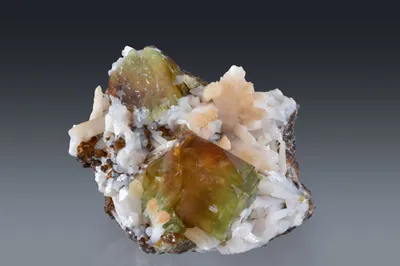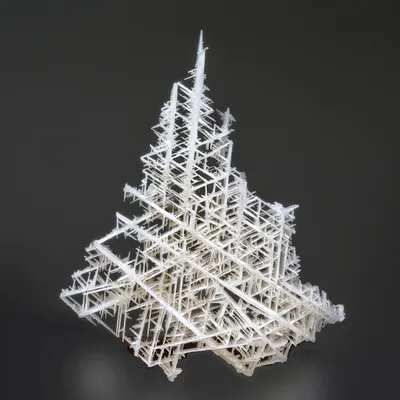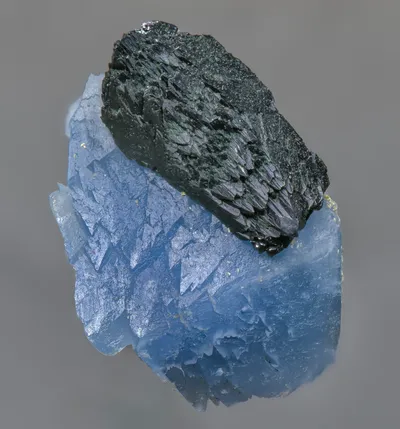Mineral Species
Scorodite
Type Locality
No
Composition
Fe3+AsO4·2H2O
Crystal System
Orthorhombic
Status at Tsumeb
Confirmed
Abundance
Very rare
Distribution
Second and third oxidation zones
Paragenesis
Supergene
Entry Number
Species; TSNB311
General Notes
The first published mention of scorodite from Tsumeb is by Geier et al. (1971) in their description of the new mineral tsumcorite. They recalled that in 1964 mining at East 49 on 30 Level encountered a cavernous portion of the ore body hosted by cherty dolomite breccia. The cavities were lined with crystalline crusts rich in beudantite, with anglesite and mimetite, and minor amounts of arseniosiderite, beaverite, carminite, pharmacosiderite, scorodite and tsumcorite (unidentified at that time).
Curiously, then, Geier (1973/1974) did not include scorodite in his table of newly found minerals from the second oxidation zone, though he mentioned it in his text as a very rare occurrence that, nevertheless, occurs in good crystals.
Bartelke (1976) described "… well-developed, often pseudo-hexagonal, dark-green crystals [of scorodite] that reach a size up to several centimetres."
Pinch and Wilson (1977) were a little more effusive:
"The scorodite crystals from Tsumeb are among the finest in the world, rivalled only by a few Mexican specimens. The crystals vary in habit from thickly-bladed to pseudo-octahedral, and reach a maximum length of about 5 cm. In daylight they are a blue-green in colour but in incandescent light they exhibit a pronounced "alexandrite effect" and appear to be an intense bluish-purple to gray-blue. The octahedral faces are adamantine but the other faces tend to be frosty to irregular. Scorodite is usually only associated with tennantite but has been reported with tsumcorite and minute crystals of powellite and anglesite."
Keller (1977a) placed scorodite as an early-formed mineral in one of his "Type II" paragenetic sequences (i.e., minerals forming under acidic conditions):
II/2: primary sulphides >> scorodite >> arsentsumebite >> anglesite >> brochantite >> cerussite (ps. after anglesite)
Lombaard et al. (1986) listed scorodite as "rare".
Keller (1984) described scorodite as light blue-green to deep dark blue masses and as idiomorphic crystals to 5 cm. The latter tend to have a pyramidal habit with {111} dominant and with subordinate {001} and {201}.
The association of scorodite with betpakdalite in the second oxidation zone was noted by Schmetzer et al. (1984) and, based on material from their study, scorodite is an associated mineral on the type specimen for gerdtremmelite (Schmetzer and Medenbach 1985).
Gebhard (1999) observed that scorodite is very often associated with some of Tsumeb’s extremely rare minerals. He recorded a single specimen with scorodite crystals (to 5 mm) in which the iron is partly replaced by gallium. This scorodite contains 9.5 % Ga2O3 (presumably wt %) and is associated with yellow crystals of gallobeudantite.
Gebhard (1999) also noted the occurrence of aluminium-rich scorodite containing "… about 10 % aluminium". The aluminium-rich scorodite exhibits a different colour change, from greenish-blue in natural light, to a "phosphorescent green" in artificial light. Aluminium-rich scorodite is an associated mineral on the type specimen of wilhelmkleinite, discovered on 44 Level, where it is also associated with adamite and gerdtremmelite (Schlüter et al. 1998).
Cook (2010) describes scorodite crystals from Tsumeb "… resembling elongate octahedra to 5 cm…".
Kampf et al. (2012) conducted a study of the heteropolymolybdate family of minerals, proposing new species and a nomenclature scheme. Tsumeb specimens of betpakdalite-CaCa and betpakdalite-CaMg (a new species) were provided from the Pinch Collection. Pinch’s labels indicate that the type specimen of betpakdalite-CaMg, associated with scorodite, is from 35 Level in the second oxidation zone, while the betpakdalite-CaCa specimen, also with scorodite and powellite, is from 30 Level.
Key (1996) described a 2.5 cm specimen from the collection of the late F. John Barlow (1914-2004; catalogue number # T144) comprising a small group of brilliant blue scorodites (to 10 mm) on a "… tennantite pseudomorph after azurite" [more likely to be tennantite after enargite]. This is a very unusual association for scorodite at Tsumeb.
Key also recalled being shown, in the early 1970s, a c. 25 cm hemispherical aggregate of gemmy blue scorodite crystals, individually to 6 cm, which he considered the finest specimen of any species that he ever encountered from Tsumeb (pers. comm. to M. Southwood, February 2015; see Southwood 2022d). The whereabouts of this specimen is unknown but a piece of broadly similar description, perhaps a little smaller, was offered by Crystal Classics at Tucson in 2019.
Associated Minerals
adamite; anglesite; arseniosiderite; arsentsumebite; beaverite-(Cu); betpakdalite-CaCa; betpakdalite-CaMg; beudantite; bradaczekite (?); carminite; ceruleite; cerussite; chenevixite; conichalcite; djurleite; enargite; ferrilotharmeyerite; gallobeudantite; gerdtremmelite; hematite; kaolinite; mansfieldite (?); mawbyite; metazeunerite; ojuelaite; pharmacosiderite; powellite; schneiderhöhnite; sewardite; stolzite; tennantite-(Zn); tsumcorite; wilhelmkleinite; wulfenite






![Scorodite (w. undetermined [GS1 (of Gebhard 1999)])](/_astro/Exhibit1_Scorodite_GS1_45mm_BCX9482_Cairncross.B3g1krIf_8Cy5n.webp)